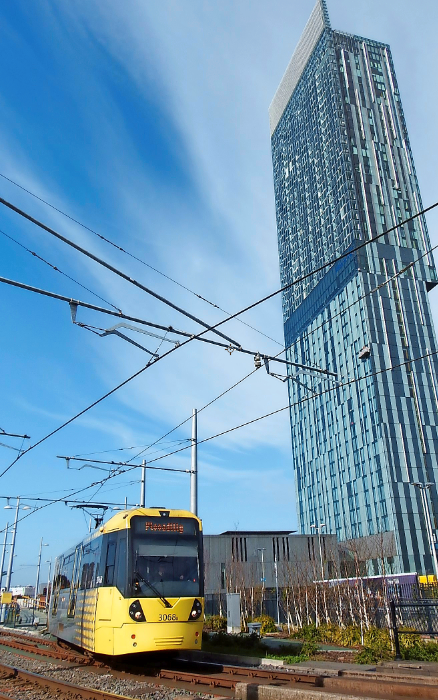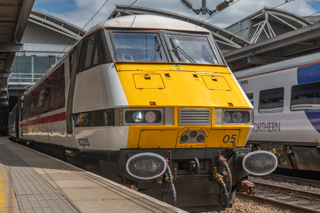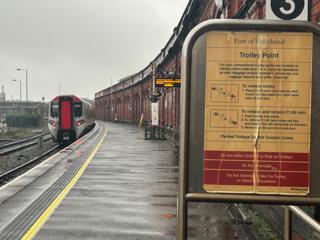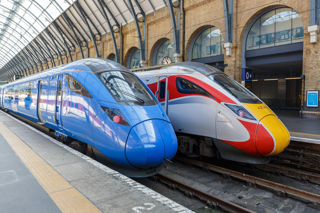From spearheading the industrial revolution more than two centuries ago, through to its more recent domination of both the UK music charts and the English domestic football scene, Manchester is a city that’s grown accustomed to being in pole position.
That statement also holds true for light rail, with Manchester Metrolink now undisputedly the UK’s largest system, having undergone two significant expansions since the first line opened between Bury and Altrincham in April 1992.
The latest of these was completed in February 2017 following the opening of the Second City Crossing (2CC), which was needed to facilitate the addition of three new lines to the existing system. Dubbed ‘The Big Bang’, this £1.5 billion Phase 3 extension programme took eight years to complete, and boosted the network’s size to more than 60 miles of track serving 93 stops, which collectively hosted an impressive 37 million journeys in 2016. Cementing its primacy even further, preparatory work began in January to add a further 3.4 miles to Metrolink, once a £350 million extension to the Trafford Centre opens in 2020.
Outgoing Metrolink Director Peter Cushing has overseen much of this expansion. He stepped down in March after four eventful years at the helm, and a decade in total of working with the organisation. He has been succeeded by former deputy Danny Vaughan, a move that coincided with a shift in focus from construction to consolidation, and the delivery of further service and operational improvements.
At the top of Vaughan’s in-tray is a change of operator in July, when the management contract with current encumbent RATP Dev Ltd expires. The incoming operator is joint venture KeolisAmey, which beat off three rival shortlisted bidders to win an operations and maintenance deal that will run for up to ten years. KeolisAmey already operates London’s Docklands Light Railway, and has pledged to create 300 new jobs - including apprenticeships and traineeships - to increase security, improve customer service and lead a crackdown on fare dodging.
To ensure a smooth and orderly transition, Cushing has stayed on in a part-time capacity to assist Vaughan until the summer, and minimise any possibility of disruption for management, staff or passengers.
Cushing explains: “I’m doing a piece of work to see the old operator out, in the nicest possible way, and that’s going pretty well at the moment. KeolisAmey takes over on July 15, so I’m working between now and then to make sure everything’s covered.
“There’s a lot of contractual stuff to do, and a lot of ancillary contracts to be novated and changed. There’s also the impact on people that needs to be managed because it can be quite unsettling to have a new party taking over. The fact is that not much will change for employees, but I’m doing a lot of work with them nonetheless.
“What we’re looking for is a seamless transition to the new operator. The average person buying a ticket in the morning isn’t going to notice anything different on July 15 - it’s like when you’ve got a favourite pub and the landlord changes. The brown stuff coming out of the tap stays the same from one day to another.”
Although Cushing stepping down marks the end of a huge capital programme for Metrolink, the size of the task facing the new man at the helm remains considerable.
Focusing more on the operating business and what Vaughan calls ‘the steady state’ should not be seen as a lack of ambition by the system’s owners Transport for Greater Manchester (TfGM), he warns, and there’s a wide range of complex and demanding programmes for him to sink his teeth into.
Not least of these is the Trafford Park extension which, although only 3.4 miles long, looks set to be one of the network’s most patronised routes by calling at Manchester United’s Old Trafford football ground (capacity 75,000), the Imperial War Museum, EventCity exhibition centre and the UK’s second-largest shopping complex, the Trafford Centre. It will also traverse what is still one of Europe’s largest industrial estates at Trafford Park.
Says Vaughan: “Although we still have extensions in the pipeline and a capital programme, it’s certainly not as big as it was, or as intense. We opened 2CC a couple of months ago and that was the last piece in the puzzle of the Phase 3 expansion. We now have a shift in emphasis to bringing in a new operator and focusing more on bringing about incremental improvements in reliability, customer service and a greater focus on asset management.
“That said, we’ve got a hell of a lot to do now that we have legal powers to start work on the Trafford Park line, which goes to a pretty busy place and cuts across a number of large stakeholders. We’re also establishing a renewals programme because, as you can appreciate, although we’ve built a lot of new lines, the original Bury and Altrincham lines (opened in 1992) are quite old now and require new investment.
“We’re still looking at places to continue to expand the network, but we now need to make best use of the network we’ve built, and to start to grow patronage on these lines and then deal with those challenges. Building 2CC to accommodate all the new lines kind of shows we’re reaching a capacity point, and that we can’t continue to add quickly and easily. We need to take it more slowly now, and consider where will benefit most from any future investment in Metrolink.”
Turning his attention back to the new operator KeolisAmey, Vaughan outlines what made theirs the winning bid in a highly-competitive tendering process. Following the rapid expansion of the system, he is also keen to manage passengers’ expectations, adding that improvements will take months rather than weeks to materialise, and will be gradually and carefully implemented rather than being rushed.
He adds: “Passengers aren’t going to see anything different on July 15 compared to July 14, but they will notice what happens after that time. We’re busy ensuring that the transition happens smoothly, and then a lot of work starts in terms of a change in systems and the recruitment of more people into the areas of sales, operations and engineering. All of this will come to fruition a couple of years down the line.
“In terms of the bid, it was about getting the right balance between price and quality assurances, and the tendering process was deliberately set up to give us the best combination of these things, the optimum solution if you like.
“We’ve ended up with a proven partnership from KeolisAmey. They manage the DLR together, and Amey also does a lot of infrastructure work on the London Underground. What was also impressive about their proposal were the examples they supplied of how they’ve improved reliability and invested in continuous improvement elsewhere. That’s exactly what they’re proposing to do here, looking at whole-life costs, modelling, asset management and rolling reliability.
“If there’s one thing passengers want more than anything else, it’s a reliable service, so we’ve done a lot to improve that over the last few years and I think this partnership will go a lot further.”
The new contract is also structured to maximise the return on investment made by TfGM in trebling the size of the network, adds Vaughan. With almost all of the £1.5 billion price tag met from publicly funded grants or loans, the business case put forward by TfGM to secure that funding will now come under close scrutiny from local and central government in order to assess how this translates into economic growth and increased ridership, as improved public transport gives better access to jobs, business, retail and leisure opportunities.
Vaughan says the management contract with KeolisAmey will play an important role in attracting and maintaining this increased ridership, through the delivery of key outputs such as improved security and operational reliability. The inclusion of targets for condition monitoring and enhanced asset management is also intended to minimise TfGM’s ongoing infrastructure costs in what Vaughan believes to be a prudent deal for the taxpayer.
“One of the more visible things to happen over time is that you’ll see more people on the network, and that increased presence will improve things like security, antisocial behaviour and the perception of personal safety on Metrolink. These things will make it a nicer place to travel.
“We’re hoping that we can grow patronage on the back of that and also from better operational reliability, and there are incentives in the contract based around this. We’ve got an interesting model and balance of risks here, because TfGM take the revenue risks, and it’s a managed contract with KeolisAmey for a fixed fee. We also take the whole life cost of renewals, and we can’t do that without an operator who’s providing that data and doing the condition monitoring. That’s an important element of this contract and that has to be a partnership. When the operator is incentivised to improve reliability, then the authority (TfGM) can only benefit from that growth in patronage.”
Looking further ahead, Vaughan could be responsible for implementing elements of TfGM’s 2040 Strategy (RAIL 823). Published in February, it sets out an ambitious vision for the City Region’s transport infrastructure and identifies its investment priorities for supporting the significant levels of economic and population growth expected over the next two decades.
Much of the strategy focuses on driving increased integration between different modes of public transport, to reduce the cost and time penalties of changing between services and to better co-ordinate travel by bus, tram and train.
With funding available from the £314 million Local Growth Fund awarded to Greater Manchester by central government in 2014 as part of the City Region’s devolution deal, many of the suggested improvements touch on Metrolink, and could come to define Vaughan’s leadership of the organisation over the coming years should they be given the green light.
They include resurrecting an idea first mooted in the 1970s to tunnel beneath the city centre to add rail-based capacity, and to introduce tram-trains on to some of the city’s suburban but financially-underperforming heavy rail routes. By sharing existing infrastructure with Network Rail, the latter would seem the more immediately achievable ambition, both for its significantly lower cost than tunnelling, and the shorter time horizons involved in converting conventional rail track to accept metro-style services.
Vaughan and his team will therefore be closely monitoring progress made on the UK’s first planned tram-train trial in Sheffield, which has been delayed because the infrastructure is not yet ready to introduce the seven tram-trains currently undergoing acceptance trials. In the longer term, however, he is a supporter of building tunnels - despite the obvious expense and engineering difficulties this might entail.
“Tram-trains are certainly one of the more achievable things in the strategy, but we don’t have any timelines on it,” adds Vaughan. “We’re keeping half an eye on what’s going on in Sheffield and have been waiting for some time to see the outcome of that trial, but you’d be mad to look at anything beyond the mid-2020s (to see tram-trains in Manchester). It depends on funding and how quick and receptive people like Network Rail are, and how it fits into their plans. There’s quite a lot of things that need to come together to make it happen, but I think the tram-train is in their interests too.
“Longer term, I don’t think Manchester could meet the aspirations it wants to by relying solely on the existing Metrolink lines across the city centre. I think we need to start seriously considering tunnels, which is obviously a very expensive type of infrastructure and would take a huge commitment, but why not?”
Vaughan is pragmatic, and accepts TfGM might well look to invest away from Metrolink in the short term and increase capacity across alternative modes of public transport.
High Speed 2 is due to arrive in Manchester in 2033, however, providing fresh opportunities for Metrolink, as will the planned £1 billion upgrade of Manchester Airport’s Terminals 2 and 3.
He concludes: “TfGM’s next 22 years is really wrapped up in our 2040 strategy. Metrolink has benefitted from lots of investment in the past few years, but we also have ambitions around the bus networks, the rail network and what we call the Greater Manchester Spatial Framework. With this you can see a timeline of investment going on in and around Manchester in housing and things like that, and we’re going to develop transport infrastructure around that spatial framework. In some cases that might mean new Metrolink routes, but it might mean building better roads or providing quality bus services.
“In some cases we are looking at Metrolink specifically, such as potentially building through Manchester Airport to a new Terminal 2, and possibly making some changes at Piccadilly station for when High Speed 2 arrives. There are also business cases for looking at new lines, such as perhaps one to Port Salford from the Trafford Park line. We have lots of ideas, and there will certainly be more to come from Metrolink.”
This feature was published in RAIL 826 on 6th May 2017
















Login to comment
Comments
No comments have been made yet.